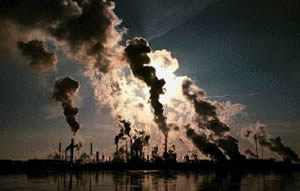
Sulfur dioxide is produced mainly by the burning of coal in the production of electricity. Black coal is reach in sulfur and forms sulfur dioxide when burnt in the furnace of a power station.
However the coal used to generate electricity in Victoria, Australia is brown coal. This form of coal is relatively young when compared to black coal and very high in water content. Although it is not as good a fuel as black coal, brown coal contains very little sulfur.
The chemical reactions involved
in the production of sulfuric acid are given below.
sulfur dioxide(SO2) + oxygen(O2) => sulfur trioxide(SO3)
sulfur trioxide(SO3) + water(H2O) => sulfuric
acid(H2SO4).
Image from Google

The chemical reactions involved
in the production of nitric acid are given below.
nitrogen monoxide(NO) + oxygen(O2) => nitrogen dioxide(NO2)
nitrogen dioxide(NO2) + water(H2O) => nitric
acid(HNO3).

Image from Google
Industry and traffic are big contributors to the production of carbon dioxide. Carbon dioxide is a product of the burning of fossil fuels. Carbon dioxide combines with water in the atmosphere to produce a weak acid known as carbonic acid.
1) Environmental Protection
Authorities (EPAs) recommend that we take the following steps to reduce
the formation of acid rain:
-turn of lights, computers and other electrical items when not in use
and only use them when necessary;
-insulate the family home;
-ride a bicycle to work as
often as you can or use public transport.
Explain how each of the recommendations listed above will reduce acid
rain.
2) The tram on the right uses electricity to power itself.
People argue that electricity
is a cleaner energy alternative than fossil fuel.
Is this correct? Explain
